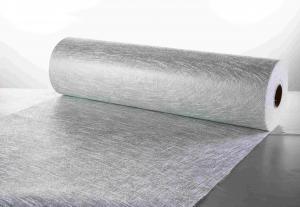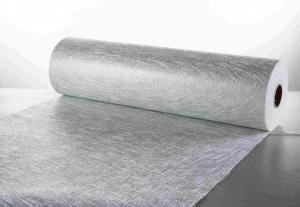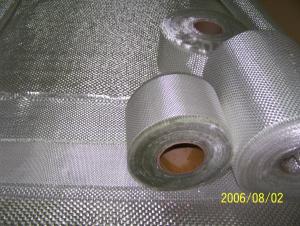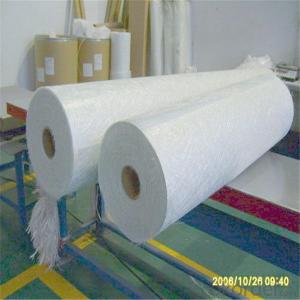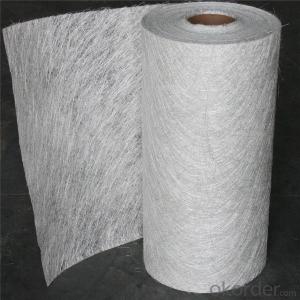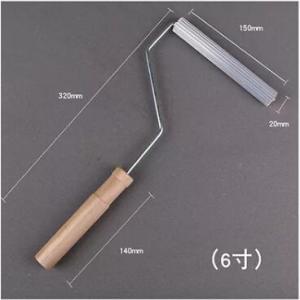E20 Emulsion E Glass Fiber Chopped Strand Mat
- Loading Port:
- Shanghai
- Payment Terms:
- TT or LC
- Min Order Qty:
- 560 kg
- Supply Capability:
- 10000000 kg/month

- OKorder Service Pledge
- Quality Product
- Order Online Tracking
- Timely Delivery

- OKorder Financial Service
- Credit Rating
- Credit Services
- Credit Purchasing
E20 Emulsion Chopped Strand Mat
E20 Emulsion Chopped Strand Mat is made of randomly distributed chopped E6 glass strands held together by an emulsion binder. E20 is suitable to reinforce unsaturated polyester, vinyl ester,epoxy and phenolic resins.
E20 is designed mainly for use in the hand lay-up process and also suitable for use in filament winding and continuous laminating processes. Its end-use applications include boats, bath equipment, automotive parts, chemical corrosion resistant pipes, tanks, cooling towers and building components.
Product Features:
◎ Good conformability.
◎ Good wet-through and fast wet-out in resins, rapid air lease, reducing rolling out time and increasing productivity.
◎ Low resin consumption.
◎ High mechanical strength of parts.
◎ Superior acid corrosion resistance.
Product Specifications:
Property | Area Weight(g/m²) | Moisture Content(%) | Size Content(%) | Breakage Strength(N) |
Methods | ISO 3374 | ISO 3344 | ISO 1887 | ISO 3342 |
EMC225 | 225(1±6%) | ≤0.15 | 4.4(1±31%) | ≥80 |
EMC300 | 300(1±6%) | ≤0.15 | 4.0(1±31%) | ≥100 |
EMC375 | 375(1±6%) | ≤0.15 | 3.8(1±31%) | ≥120 |
EMC450 | 450(1±6%) | ≤0.15 | 3.7(1±31%) | ≥140 |
EMC600 | 600(1±6%) | ≤0.15 | 3.5(1±31%) | ≥160 |
EMC900 | 900(1±6%) | ≤0.15 | 3.3(1±31%) | ≥200 |
Packaging:
Each Emulsion Chopped Strand Mat is wound onto a paper tube which has an inside diameter of 90mm. The roll outside diameter is approximately 265mm. Each roll is wrapped up in plastic film and then packed in a cardboard box. The rolls are stacked horizontally or vertically onto pallets. All pallets are stretch wrapped and strapped to maintain stability during transport.
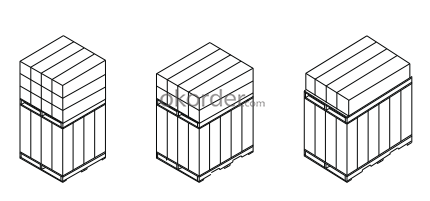
Storage:
Unless otherwise specified, the fiberglass products should be stored in a dry,cool and moisture-proof area. The fiberglass products should remain in their original package until prior to use. The room temperature and humidity should be always maintained at -10℃~35℃ and ≤80% respectively. It is best if the product is used within 6 months after production date.
- Q:nan
- Geogrid is a major geosynthetics. Compared with other geosynthetics, it has a unique performance and effectiveness. Geogrid is usually used as the reinforced soil structure tendon material or composite material geosynthetics. The geogrid is divided into plastic geogrid, steel plastic geogrid, glass fiber geogrid and fiberglass polyester geogrid. (1) The plastic geogrid is Polymer netting materials with a square or rectangular shape after pultrusion. According to the direction of pultrusion, it can be divided into uniaxial?tension and two-way stretch. It is punched in the polymer sheet material (raw material is polypropylene or high density polyethylene) after pultrusion, and then operate orientation stretching in heating codition. The aniaxial tension geogrids is made only along the length direction of the sheet, while the two-way stretching gridgeogrids is made by pultrusion the aniaxial tension geogrids along the direction which is vertical to the length.
- Q:Where can I cut short glass fiber?
- Wellav glass fiber glass fiber to shred section as an example, mainly used for reinforced thermoplastic plastic, such as plastic added to increase strength and toughness, or manufacturing of automotive insulation cotton etc..
- Q:nan
- Nylon is made by the existing PU foaming material as the core material and the rudder; 6) It can realize automation to labor saving; 4) Usually, wet layer tools can be improved for the forming process.10 20, Take down the products, with roving, fiberglass surface felt. In most cases, the curing agent can be used in ambient temperature, unlike RTM aluminum which is smooth on both sides. Glass fiber roving for pultrusion has some effect in the core material. It is generally more brittle after curing: General by using multi-purpose epoxy: This method is usually adopted, because it is not harmful to health.
- Q:nan
- It is used for high quality asbestos tiles and glass fiber reinforced cement.
- Q:nan
- Classification of glass fiber (5) poor water-absorbing quality. The glass fiber monofilament diameter rangingfrom a few microns to twenty micron, with the development speed aheading. Its characteristics are as follows. (2) the elasticity coefficient is high, and the heat resistance is good: (1) High tensile strength It is widely used in various fields of national economy, but it is not suitable for being structural material thread, with the character of noninflammability, no radiation and special odors. (7) preety machinability. The English name is, therefore, with the resin to give shape after finally it can become excellent structural material, usually used as a composite material in the reinforcement material. (6) scale stability. (8)The transmission and light transmission make the use of glass fibers more broadly than other species of fibers, and it is insulating materials and insulation materials. Each bundle of fibers are made of hundreds or even thousands of root root filaments, woven cloth and other products, different the morphology of the staple fiber and glass fiber, so the absorption of impact energy is good: Glass fiber is equivalent to a hair and an be buddle into a strand. Glass fiber increases the intensity with diameter smaller. It is easily lunge the skin and belongs to a crisp fiber. (10) the price is cheap and fiber is very thin. Properties of glass fiber, high alkali: Finally, it becomes various types of products, so take good care of it.
- Q:nan
- The former one is called carbon - carbon composite material which is made from carbon fiber.
- Q:nan
- There are acidulous groups on the surface of the glass fiber, but it is difficult to bund, so after chopping, it is easily pilling, which will affect the surface tension.
- Q:nan
- Drawing, drying, winding, fabric etc.
- Q:nan
- The process of glass fiber generally includes: Purchase raw materials, mix according to the formula, and then transferred to the glass furnace for melting and refining, after operation channel flow to the bushing, the sizing agent after coating by wire drawing machine traction, then form the original cake, and then flow to the rear section reprocessing procedures (usually a short cut, winding, weaving, puffing and twisting) or sell (direct yarn)
- Q:nan
- Milled glass fiber is made from specially drawn continuous glass fiber by chopping, grinding and sieving.
1. Manufacturer Overview |
|
|---|---|
| Location | |
| Year Established | |
| Annual Output Value | |
| Main Markets | |
| Company Certifications | |
2. Manufacturer Certificates |
|
|---|---|
| a) Certification Name | |
| Range | |
| Reference | |
| Validity Period | |
3. Manufacturer Capability |
|
|---|---|
| a)Trade Capacity | |
| Nearest Port | |
| Export Percentage | |
| No.of Employees in Trade Department | |
| Language Spoken: | |
| b)Factory Information | |
| Factory Size: | |
| No. of Production Lines | |
| Contract Manufacturing | |
| Product Price Range | |
Send your message to us
Similar products
New products
Hot products
Related keywords
You Might Also Like
